
- •Executive Summary
- •Introduction
- •City Context
- •Education Context
- •Conceptual Framework for Effective Learning Environments
- •Main Findings
- •Main Conclusions
- •Recommendations
- •Annex 1 School Selection and Data Collection Instruments
- •Annex 2 Characteristics of School Design
- •Annex 3 Use of Learning Environments
- •Annex 4 Technical Characteristics of Schools Visited
- •Annex 5 Data Collection Results
- •Annex 7 Agenda of Meetings

|
School Design and Learning Environments |
|
in the City of Espoo, Finland |
36 |
December 2018 |
Annex 3 Use of Learning Environments
Research Protocol: Selected Espoo District LEaRN Evaluation
Five theoretical concepts underpin the LEaRN contribution to this analytical framework.
21st century learning skills: At best, a re-conceptualisation of international curricular goals, but in reality a loosely conceptualised phenomenon, these skills have been prescribed in key policy documents from a number of countries over a long period of time (for example the UKs Plowden Report, and Australia’s Melbourne Declaration), and have been developed into a wide educational discourse. In general, this concept argues:
•The 21st century requires, and will require, graduates with a set of skills not necessarily being addressed by traditional compulsory-education programmes;
•These skills focus on interpersonal qualities, rather than functions that can be seen as routine cognitive;
•Four key characteristics summarise these skills – Communication Skills, Critical Thinking Skills, Creative Thinking Skills, and Collaboration Skills, or the 4Cs.
As a component of this conversation:
•It is further argued that the 4Cs cannot be adequately developed through traditional ‘teachercentric’ pedagogies, which are a feature of traditional classroom environments;
•Flexible, adaptive learning spaces must be built to accommodate student-centric pedagogies;
•It is argued that the development of so-called Innovative Learning Environments (ILEs) has the capacity to meet this need.
Student deep learning
Differentiated learning (the concept that students learn in different ways, and instruction must recognise and facilitate this) is one principle that has driven much quality educational curriculum theory for many decades. It underpins innovations such as problem-based learning, inquiry-based learning, and student-centred learning. An indicator of differentiated learning is the degree to which students occupy a ‘superficial to deep learning’ continuum; in simplistic terms, superficial learning is what occurs when students study simply to meet assessment requirements, and deep learning is using knowledge to explore relevance and build personal beliefs. In the context of this project, ‘deep learning’ is considered the optimum. While deep learning theories enjoy a wide and varied educational research discourse, Biggs is one proponent who has articulated measurable characteristics of deep learning (see table below). These are embedded in LEaRN’s Space Design and Use (SDU) survey (Imms, et al, 201722).
22Imms, W., Mahat, M., Murphy, D. & Byers, T. (2017). Type and Use of Innovative Learning Environments in Australasian Schools – ILETC Survey. Technical Report 1/2017. Melbourne, Australia: LEaRN, University of Melbourne. Retrieved from http://www.iletc.com.au
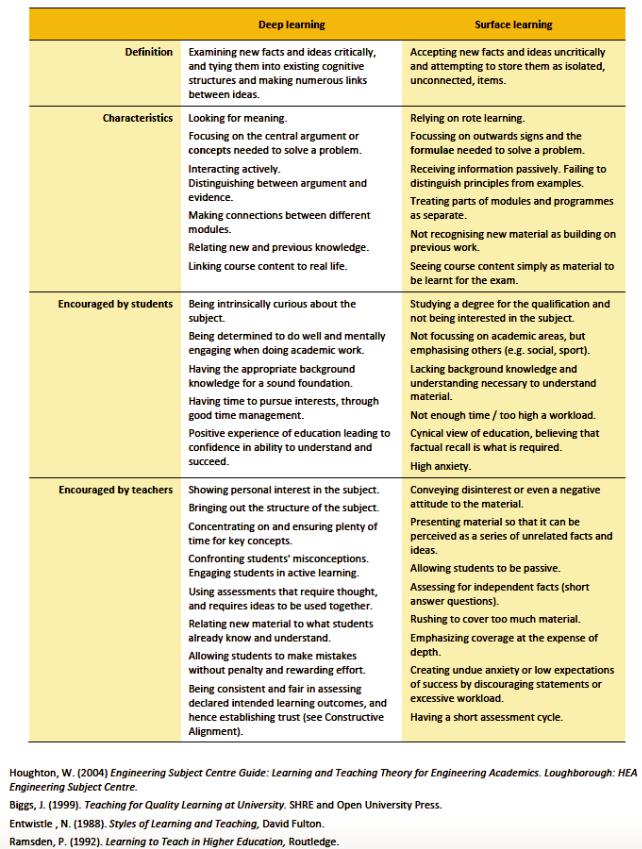
School Design and Learning Environments |
|
in the City of Espoo, Finland |
|
December 2018 |
37 |
Table 1: Measurable characteristics of deep learning

|
School Design and Learning Environments |
|
in the City of Espoo, Finland |
38 |
December 2018 |
Teacher mind-frames
Educational research consistently finds that the most significant factor impacting students’ learning outcomes is quality of teaching. As one example, Hattie’s (2011/2017) synthesis of >1000 meta analyses on student learning outcomes creates an empirical ‘hierarchy’ of the educational factors proven to impact student learning. High-effect (>d 0.4) factors in this hierarchy are facilitated by teacher actions. Hattie conflated these into a set of 10 characteristics – the ‘10 Teacher Mind-frames’ (Hattie & Zierer 201723). These are embedded in the SDU survey.
The existence of an informative ‘typology’ of learning environments
It cannot be assumed ILEs conform to an easily summarised type. On the contrary, they vary considerably, with this diversity driven by (1) complex community needs, or educational philosophies underpinning their design; (2) the pedagogic aspirations of the school, to be enacted in the design; (3) architectural responses to these educational briefs; (4) the actual use of the spaces. In combination, these factors result in a myriad of design solutions. The typologies, summarised by Dovey and Fisher (2014),24 are the result of an analysis of design characteristics in international school design awards. The resultant ‘typology’ of these solutions is not intended to illustrate actual designs; instead they provide a characterisation of spaces for further analysis and examination. These five typologies are embedded in LEaRN’s SDU survey.
Evaluation of the effectiveness of innovative learning environments
Evaluation of learning environments is an imprecise and underdeveloped concept. However, some significant milestones towards this goal have been accomplished by organisations such as the OECD’s CELE group, and the LEaRN research centre. Six issues are characteristic of these goals:
•No one evaluation tool can adequately capture the required data;
•Any evaluation must incorporate the needs of the clients and the purpose of the build (Imms, Cleveland and Fisher, 201625);
•It is possible to empirically summarise the pedagogic and design intentions of the build – this is preferable to singular qualitative analyses;
•The simplest but methodologically weakest approach is to carry out preand postimplementation surveys;
•The most difficult but methodically most effective approach consists of randomised control trials or, if not possible, comprehensive longitudinal studies that utilise complex psychometric measures;
•The best approach when considering cost and effect, is a repeated measures design capable of isolating space as a variable, such as a single-subject research design (for example Byers and Imms, 201626).
An overview of this conceptual approach is presented in Imms (2016a). The Espoo project, while not an evaluation, will draw on these principles to collect data needed to meet the goals of the review.
In terms of evaluation tools capable of capturing these data, LEaRN has a suite developed over the past decade of research. However, in recognition of the short field work timeframe and limited budget, this project will utilise one validated tool, LEaRN’s SDU survey. From this, a cluster of interview/observation topics will be derived.
23Hattie, J & Zierer K (2017) Ten Mindframes for Visible Learning, Routledge, UK
24Dovey, K. & Fisher, K. (2014). “Designing for Adaptation: The school as Socio-Spatial Assemblage.” Journal of Architecture doi.org/10.1080/13602365.2014.882376
25mms, W., Cleveland, B. & Fisher K., Eds. (2016). Learning Environments Evaluation. Snapshots of Emerging Issues, Methods and Knowledge. Amsterdam, The Netherlands: Sense Publishing.
26Byers and Imms, 2016 - Imms, W., Mahat, M., Murphy, D. & Byers, T. (2017). Type and Use of Innovative Learning Environments in Australasian Schools – ILETC Survey. Technical Report 1/2017. Melbourne, Australia: LEaRN, University of Melbourne. Retrieved from http://www.iletc.com.au
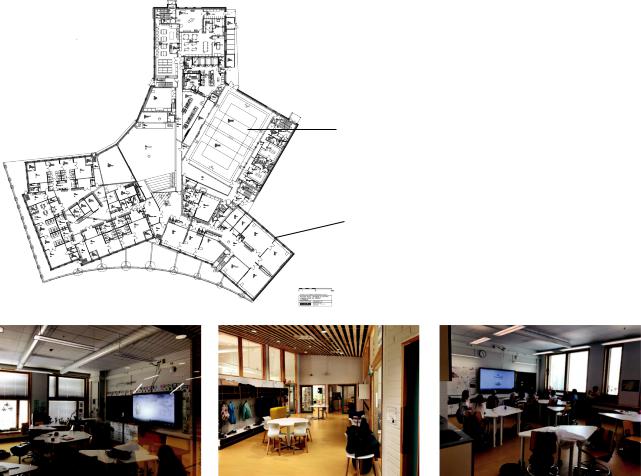
School Design and Learning Environments |
|
in the City of Espoo, Finland |
|
December 2018 |
39 |
Annex 4 Technical Characteristics of Schools Visited
Aurora School
The building is planned around a central space, which forms the school hall and auditorium, and three wings. In one wing is the daycare centre, which is single storey (this part of the building was not visited during the review visit), the second wing has the classrooms grouped around a central learning space over two storeys, and the third wing has art and music classrooms with a maternity and child health clinic on the first floor.
Each wing is relatively wide, which means that the centre of such a plan could be very dark. However, this has been avoided by opening up views through the building that also bring light deeper into it. Glazed panels are used in many parts of the interior of the building to enable the light to penetrate through the building. The overall impression is a visually light building where one gets a sense of the connection between spaces.
The main entrance to the building brings people into the central space from which the main circulation route will take them to the different parts of the building. While the daycare centre can be accessed from within the building, it also has its own main entrance.
Throughout the building, the surface materials include concrete and natural finish wood, with splashes of colour from the furniture.
Aurora School
Ground floor plan
Hall and raked seating
Classrooms grouped around central space

|
School Design and Learning Environments |
|
in the City of Espoo, Finland |
40 |
December 2018 |
1.Technical characteristics of the main learning spaces
•Size: Classroom sizes range from about 20sqm to 55sqm.
•Shape: Rectangular
•Adjacencies: Classrooms are clustered. Groups of 4, 5 and 6 open off a common learning space. Some classrooms have doors connecting to adjacent classrooms.
•Interconnectivity: Not a feature in this school.
•Furniture: Generally, the chairs are adjustable and can be wheeled across the rooms. In the classrooms, triangular shaped tables are used and can be arranged in a variety of layouts for individual or group work. Circular and rectangular tables are used in some other areas.
•Whiteboards / display screens: Whiteboards/blackboards are fixed at the front of the classroom.
•Transparency: Some of the spaces have glazed panels, some have full-height glazing and some only have vision panels and fully glazed doors. High level glazing along the top of the interior walls of the classrooms adjacent to the internal learning space and corridors enable light to penetrate into the interior.
2.Classrooms
The classrooms are in groups of 4, 5 or 6 and clustered around common open learning areas where informal learning settings have been created and lockers and coat racks are located. The main hall has, on one side a stage, and, on the other, raked seating that steps up to form a stairway to the next level. In the daycare section, which occupies the ground floor of one wing, activity rooms are arranged around a central common space. Adjacent to each activity room is a sleeping area providing separate but connected spaces for sleeping and play.
3.Library/commons
The library/commons area is situated on the first floor, adjacent to the stairway at the top of the auditorium. It is a fully enclosed space with a glazed wall on one side overlooking the kindergarten on the floor below. Bookshelves are arranged around the perimeter of the space, with freestanding tables and chairs throughout the space.
4.Multi-function space
The school hall has a multi-function purpose being used for performances, school assembly and dining. At one end of the auditorium there is a stage and, at the back opposite the stage, there are fixed benches that rise up like a ‘grand stairway’. To one side, there is a second large multifunctional space, accessed off the main space.
5.Adjustability, Agility and Flexibility in use
Most of the learning spaces, i.e. classrooms, have fixed walls and therefore there is limited opportunity to adjust their size. The spaces themselves seem to be quite agile and the furniture can be easily rearranged. The flexibility in use of the spaces, or the immediate choices that teachers and students may have for using different spaces or spatial configurations, is to some extent constrained by the fixed walls of the classrooms; however, the larger spaces, such as the multi-purpose spaces and library/commons, do offer some opportunities for flexibility.
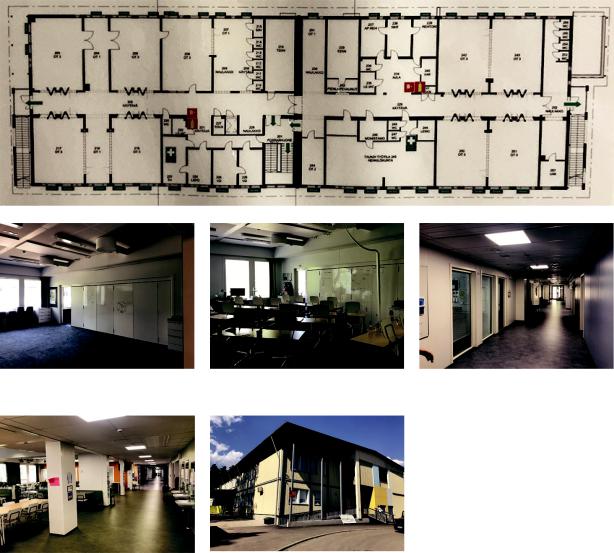
School Design and Learning Environments |
|
in the City of Espoo, Finland |
|
December 2018 |
41 |
Karhusuo School (module-prefabricated model)
The Karhusuo School is constructed using prefabricated modular units which are assembled on site. One advantage of this approach to construction is speed: being able to mass produce modules in a factory is quicker than site-based construction because the modules can simply be copied, thus reducing unique features, and a factory is not affected by weather, which may stop site-based construction. Another advantage is lower cost: automated systems can be used in the fabrication and the same tooling, moulds and construction used, thus reducing the need for bespoke solutions. If the building is designed to an industry standard modular dimension, components such as ceiling tiles, windows, partition panels can be used without needing any special components. With a focus on fewer construction details, because the components are essentially being repeated, the quality of the product can be maintained. Moreover, in a factory the modular components can be assembled and modified if necessary before final production, which is harder to do on a construction site.
The plan of the Karhusuo School is linear with classrooms either side of a corridor running down the centre of the building. The main entrance is at one end of the building in line with the corridor which runs down the centre of the building. To one side, the corridor opens directly into the dining area, which is approximately the size of three classrooms. Staircases at the end and in the middle of the building lead to the upper floor.
Classrooms separated by folding partitions which have writeable surfaces
The corridor may be too small to create learning activity zones
The corridor opens into the dining area
|
School Design and Learning Environments |
|
in the City of Espoo, Finland |
42 |
December 2018 |
1.Technical characteristics of the main learning spaces
•Size: The classrooms are all of similar size.
•Shape: Rectangular
•Adjacencies: Classrooms off corridors. Some pairs of classrooms linked by folding walls for their full width so that the classrooms can be joined together in a variety of permutations. Also, in some cases folding walls can open onto the corridor.
•Glass walls: Not a feature in this school.
•Interconnectivity: As noted above, a few classrooms are connected to each other and/or the corridor by folding walls which can be fully opened up to create a much larger space.
•Furniture: Generally, classrooms have chairs on wheels with single rectangular desks without wheels, although they seemed light enough to be relatively easily movable. We observed some rooms particularly used for art with larger tables.
•Whiteboards / display screens: Whiteboards are fixed at the front of the classroom.
2.Classrooms
The classrooms are of uniform size and are linked to each other in one of two different ways. Some classrooms are linked by a folding wall which can be opened to create a larger space. Other classrooms are linked by doors so that the overall configurations of the rooms remain the same but enable connectivity between the two. While the classrooms open off the corridors on both floors of the building, several have folding walls to the corridor. In one part of the school, a pair of classrooms are not only linked to each other by retractable walls, but both also open onto the corridor with a mirrored pair of classrooms on the other side of the corridor, potentially providing a large open space. At one end of the building, on the first floor, classrooms are separated from each other by a narrower space that serves the rooms on each side of it via a folding wall, which increases the options (see plan).
3.Corridors
Although the corridor had some seating in it, it may be too narrow to create spaces which could be used as learning areas. As noted elsewhere, some of the classrooms can be opened up onto the corridor.
4.Adjustability, Agility and Flexibility in use
Adjustability is facilitated by extensive use of folding partitions, as discussed above. The spaces seem to be quite agile and the furniture can be easily rearranged.
The school offers some flexibility in use, primarily by adjusting the size of the spaces, although the dining area provides another space that could be used for learning activities. The corridors do not offer any significant opportunity for creating learning zones.
School Design and Learning Environments |
|
in the City of Espoo, Finland |
|
December 2018 |
43 |
Kirkkojärvi School
The Kirkkojärvi School was constructed in 2010. The plan of the school is in the shape of two ‘V’- shaped wings that are linked by an atrium, a multi-purpose space that is three storeys high and forms the heart of the school. The main entrance is directly into the atrium, which is a multi-functional space used for general assembly and dining; it is also the most public part of the building.
The plan of the school is arranged so that the primary school is in the smaller wing and the secondary school in the larger. Classrooms are grouped along with a semi-enclosed ‘home’ area, forming learning clusters. Each home area has its own colour scheme which is reflected in the corridors leading to the classrooms. The home areas have their own lobbies to the external yards, although they are kept separate from the main public space in the centre of the building. The aim is to provide some intimacy and connection for groups of students, but at the same time to enable them to be part of the whole school.
The corridors, which get wider towards the end of each wing and open into a home area, a semienclosed learning space, are generally lined with lockers neatly positioned so that the front face of the lockers align with adjacent wall surfaces, which illustrates the attention paid to design detailing in this school.
During the review visit, the corridors spaces were being used as ‘streetspace’ in that there was informal seating available for students.
In general, the classrooms range from 42sqm to 60sqm, are rectangular in shape and open directly onto the corridors. There are some classrooms that are larger, up to 90sqm, such as for technical and practical classes. There appear to be no moveable partitions between the rooms or other spaces. The doors to the classrooms have full height vision panels allowing some view into the rooms.
The wall finishes are generally exposed brick, which gives the building a warm and robust feel. The ceiling finishes throughout are a dark grey, which reduces the reflectance of the ceilings.
Conversations with the teachers suggested that the classrooms on the south façade tended to be too cold in winter. However, no temperature data was gathered during the review visit to verify this.
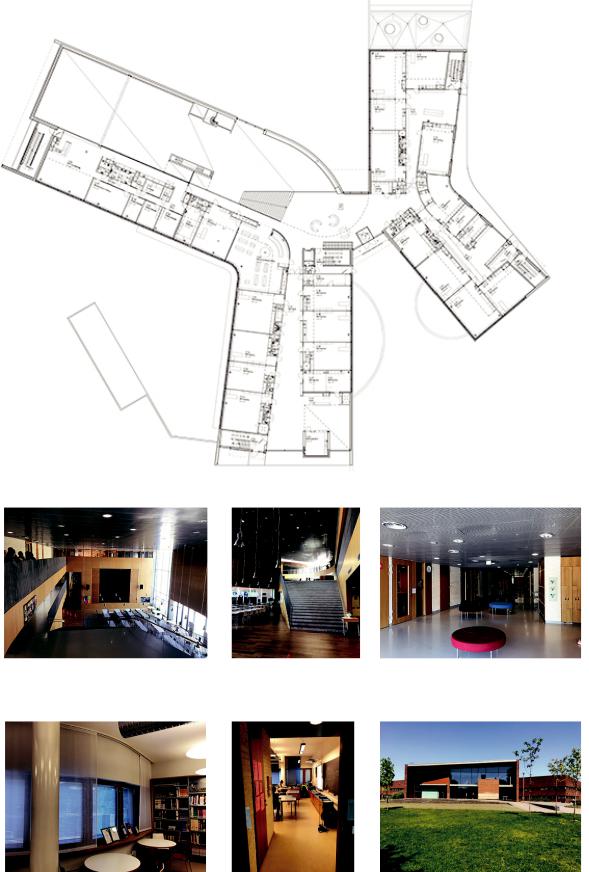
|
School Design and Learning Environments |
|
in the City of Espoo, Finland |
44 |
December 2018 |
Atrium space which gives access to the public areas of the building. At one end is a stage
The library
A grand stairway leads up from the atrium to the first floor
In the classrooms the desks tended to be in rows
From the home base, the classrooms are accessed off the corridor
Each end of the wings give access to the home bases on the ground and first floors
School Design and Learning Environments |
|
in the City of Espoo, Finland |
|
December 2018 |
45 |
1.Technical characteristics of the main learning spaces
•Size: In general, classrooms range from 42sqm to 60sqm. Practical classrooms are generally larger, up to 90sqm.
•Shape: Rectangular
•Adjacencies: Classrooms off corridors.
•Interconnectivity: Openable walls are not a feature in this school, but some classrooms are connected by doors.
•Furniture: Generally, classrooms have chairs on wheels with single rectangular desks without wheels although they seemed light enough to be relatively easily movable. We observed some rooms particularly used for art with larger tables.
•Whiteboards / display screens: Whiteboards are fixed at the front of the classroom.
•Glass walls: Generally not a feature in this school except for the practical classrooms on the ground floor.
2.Learning clusters
Each learning cluster has five or six classrooms and an open learning space. The open learning spaces are either connected directly to the outside play areas or are connected via a stairway.
3.Library / Open commons
A library area opens off the main atrium space, providing a separate but connected space to the atrium. It is adjacent to the main entrance and its central location places it along the circulation route
4.Multi-purpose
The position of the multi-purpose commons area means that it is at the heart of the building and is a hub from which the main circulation routes radiate. As a multi-use space with a stage at one end it can be used in a variety of ways from large gatherings, performance space and for dining – the catering facility is adjacent to it.
5.Adjustability, Agility and Flexibility in use
Most of the learning spaces, i.e. classrooms, have fixed walls and therefore there is limited opportunity to adjust their size.
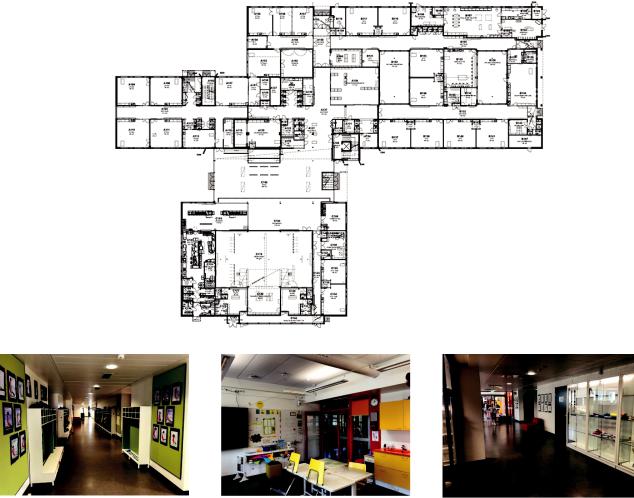
|
School Design and Learning Environments |
|
in the City of Espoo, Finland |
46 |
December 2018 |
Päiväkehrä School
The school was originally constructed in 1975 and renovated in 2016/17. The renovation included adding some new accommodation and altering the position of the library.
The plan of this building is arranged into three wings. In one wing, the classrooms are arranged along corridors with internal open courtyards; a smaller wing has a double-loaded corridor with six classrooms on the ground floor and nine learning spaces on the first floor. The third wing contains a sports hall/gym and kitchen.
An important part of the renovation was the link that was constructed between the sports hall and the main building. This created a large multi-functional space which forms the hub of the school, providing an area that can be used in a variety of ways. The main entrance to the school is through this space.
Corridor lined with lockers |
Classrooms connected by a small |
|
work space |
Display cabinets provide an opportunity to show students’ work

School Design and Learning Environments |
|
in the City of Espoo, Finland |
|
December 2018 |
47 |
A glazed rooflight runs along the length of the new roof linking the teaching wing on the right to the sports hall.
The link between the teaching wing on the right and the sports hall.
On the far side of the multifunction space is a stage and the sports hall behind.
1.Technical characteristics of the main learning spaces
•Size: Classroom sizes generally range from about 56sqm to 60sqm. A range of layouts was observed, some group layouts and conventional presentation styles
•Shape: Rectangular
•Adjacencies: Classrooms off corridors. There were pairs of classrooms linked by an enclosed teacher workspace that can accommodate two teachers. This small space has glazed partitions and a glazed door to each classroom offering the opportunity for interconnectivity between two rooms. Other pairs of classrooms are connected by double doors. Two pairs of classrooms on the first floor have an openable wall along their full width so that the classrooms can be joined together.
•Interconnectivity: As noted above, a few classrooms are connected by openable walls which can be fully opened up to create a much larger space.
•Furniture: Generally, classrooms have chairs on wheels with single rectangular desks without wheels although they seemed light enough to be relatively easily movable. We observed some rooms particularly used for art with larger tables.
•Whiteboards/display screens: Whiteboards are in a fixed position.
•Transparency: Glass walls are not a feature of the classrooms apart from class panels in the connecting teacher offices. The glazed doors and glass vision panels beside the doors give some sense of transparency and make the activities in the classroom visible from the corridors. As the glazed areas are relatively small they limit the distraction and enable the classroom to maintain a degree of enclosure.
2.Fixed function classrooms
There is a range of fabrication classrooms where students use metal and wood to make objects. These have a range of benches and other supporting equipment. We noticed that they had moveable LCD screens rather than relying on a screen in a fixed position. Power cables also dropped down from the ceiling providing a high degree of flexibility in being able to rearrange the layout of the room and, possibly, in the long term, being able to use the space for different activities.
3.Commons/library
The library, which is about twice the size of a classroom, is positioned centrally in the larger wing of the building; two of its four walls are fully glazed onto adjacent corridors and a third wall has windows, making this a very light space. When entering this wing from the main entrance, the library space is the most prominently visible learning space. In this space there is a range of moveable furniture and book shelves.
4.Streetspace and corridors
The corridors, which seemed to be reasonably generous in width, are lined with some lockers and are just adjacent to the external courtyard with high tables for students to work at. There are some alcoves or ends of corridors with seating. It would be interesting to see if learning zones could be incorporated into them.
|
School Design and Learning Environments |
|
in the City of Espoo, Finland |
48 |
December 2018 |
5.Multi-function space
This large multi-function rectangular space links the teaching wing with the sports hall and catering kitchen and main classroom wings, and forms the main entrance to the school. The two side walls including the entrance are glazed. Sliding wall panels on the back of the adjacent sports hall enable the two spaces to be opened up. There is a raised dais against one wall on which is fixed a large projection screen.
6.Staff work rooms
The teachers have a work and social area and there are several small meeting rooms.
7.Adjustability
In terms of adjustability, interconnectivity between classrooms offers scope for spatial reconfiguration, although it is not possible to open the space out fully.
8.Agility
The spaces themselves seem to be quite agile and the furniture can be easily rearranged.
9.Flexibility in use
The flexibility in use is made easier by the greater interconnectivity of some of the spaces in this school, which provides more opportunity to use different spaces, although the choice may be limited by the lack of variety of space types.
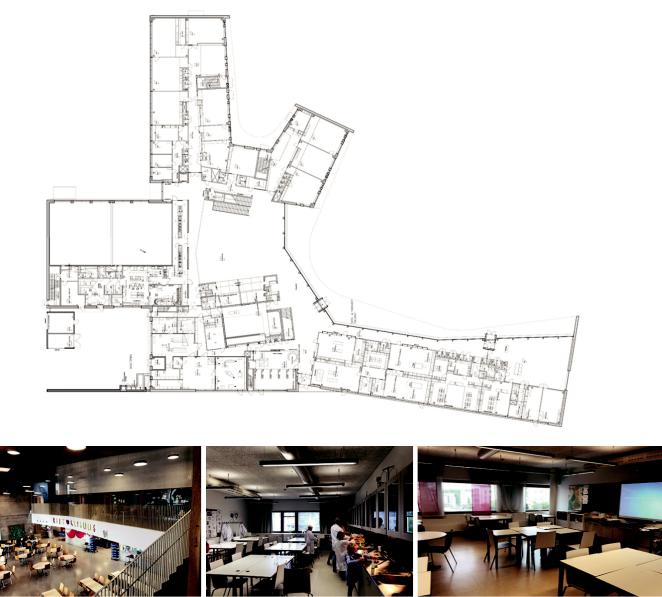
School Design and Learning Environments |
|
in the City of Espoo, Finland |
|
December 2018 |
49 |
Saunalahti School
The Saunalahti School was designed by the same architect as the Kirkkojärvi School and constructed two years later. Although it uses a similar architectural language/grammar, such as the clustering of the classrooms, wall finishes and detailing of the finishes in general, the most noticeable difference was the ceiling finish which is much lighter in colour.
The building is arranged around a central ‘heart’ space, a multi-purpose space which is used as a dining hall and general assembly area. Adjacent to the main entrance, it is the most public part of the building. The central space gives access to the learning areas for different age groups as well as the communal facilities including a library and youth centre.
The classrooms for the younger students are organised as home areas with their own lobbies to the outside yards.
The building is positioned on the site so that the school yard for the younger students gets the morning and mid-day sun, as their school day is shorter, whereas the yard for the older students gets the sun later in the afternoon.
Looking over the atrium/multi- |
Science spaces |
Generic classroom spaces |
purpose space |
|
|

|
School Design and Learning Environments |
|
in the City of Espoo, Finland |
50 |
December 2018 |
The library is adjacent to the main entrance and available for community use
Finding a nook where students can make their own learning space
Corridors open into a common learning space
Technical characteristics of the main learning spaces
1.Classrooms:
•Size: In general, classrooms range from 40sqm to 60sqm. Practical classrooms are generally larger, up to 80sqm.
•Shape: Rectangular
•Adjacencies: Classrooms off corridors. A few classrooms have doors that connect them to adjacent classrooms.
•Interconnectivity: Not a feature in this school.
•Furniture: Generally, the chairs and tables, although relatively light in weight, are neither adjustable in height nor have wheels. However, as observed during the review visit, the fact that the chairs cannot be wheeled across the rooms did not stop the teachers using a range of settings in the spaces.
•Whiteboards / display screens: Whiteboards/blackboards are fixed at the front of the classroom.
•Transparency: Glass walls are generally not a feature in this school except for the practical classrooms on the ground floor.
2.Library/commons
The library is placed adjacent to the entrance on the ground floor. The corner of the library next to the entrance has sliding glass panels so that it can be opened up into the entrance foyer space.
3.Atrium
The position of the atrium means that it is at the heart of the building and is a hub from which the main circulation routes radiate. The entrance to the school is placed near the library so that visitors are brought in adjacent to the library which is a community resource. As a multi-use space with a stage on one side, it can be used in a variety of ways from large gatherings, as a performance space and for dining – the catering facility is adjacent to it.
4.Adjustability, Agility and Flexibility in use
Most of the learning spaces, i.e. classrooms, have fixed walls and there is therefore limited opportunity to adjust their size.

School Design and Learning Environments |
|
in the City of Espoo, Finland |
|
December 2018 |
51 |
Tapiola School and High School
The renovation of the Tapiola School was completed in 2016. Deterioration in the fabric and poor air quality caused particularly by damp had led to the need to move students out in 2011-2012. However, as the school is located in a nationally significant cultural-historic area, one of Finland’s first ‘Garden Cities’, it was not possible to demolish the school. The building has therefore been extensively renovated. Although part of it had to be completely rebuilt, the overall plan and urban design form had to be preserved. A mechanical ventilation system, the plant and ductwork were constructed under the building rather than being placed on top of it, as might often be the case. Construction of the original building was completed in 1958, with further additions built during the 1960s and 1980s.
The plan of the building and the arrangement of the classrooms follow a conventional layout with classrooms along corridors. In some cases, there are fully glazed partition walls on the corridor wall of some of the classrooms and some of these glass walls slide open so that classrooms can be fully opened into an adjacent hall area. Although none of these were open during our visit, teachers did comment that they would have liked more moveable walls, suggesting that they might take advantage of such opportunities. The use of glazing does enable light to enter spaces from two sides and reduces the sense of enclosure.
Most of the classrooms are rectangular, but twelve are hexagonal, reflecting some of the experimentation in school design internationally during the late 1950s and 1960s, with experimentation with room sizes and shapes.
The main auditorium and canteen area are adjacent to the main entrance on the east side of the building. The sports hall is on the west side of the building. The architects chose to use some of the original colours on corridor walls. Not only does this give an insight into what the building might have been like, but the use of colour in this way breaks up the perceived length of the corridor.
Courtyard plan
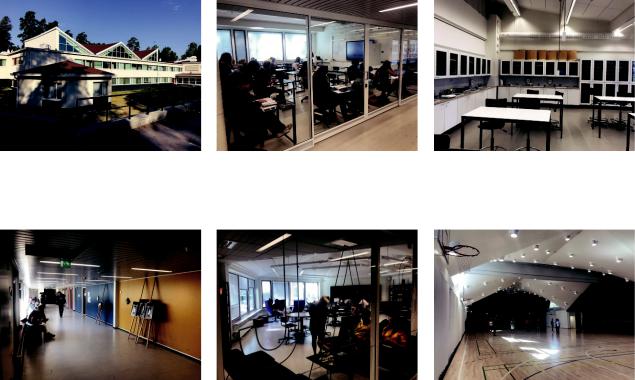
|
School Design and Learning Environments |
|
in the City of Espoo, Finland |
52 |
December 2018 |
The form of the original building has been preserved
Classroom: Glass wall to corridor with sliding panels
Science classroom: Cabinets and sinks around perimeter so that the centre of the room can be used in different ways
The corridors have been painted |
Library/Commons |
Sports hall. Original concrete roof |
using some of the original colours |
|
preserved |
1. Summary of space types |
|
|
|
Space type |
Comment |
|
General classroom |
Rectangular and hexagonal |
|
Fixed function classroom |
For sciences; cooker/domestic; wood/metal work; language labs; auditorium |
|
Commons/Library |
Yes, but fully enclosed |
|
Streetspace |
Yes, but limited |
|
Meeting rooms |
Yes |
|
Multi-function space |
Canteen space |
|
Halls |
For sports and exercise |
|
Teacher work spaces |
Meeting rooms |
|
Outdoor learning space |
External courtyard areas |
2. Technical characteristics of the main learning spaces
This summary focuses on the main learning spaces, the classrooms.
•Size: Typically, the rectangular classrooms accommodated 24 to 25 students. During the review visit most were conventionally set out with desks arranged in rows facing the front. Although we have not been given specific sizes of the spaces, they looked to be sized to accommodate about 25 students.
•Shape: Rectangular and hexagonal. The shape of the hexagonal classrooms, particularly in a relatively small room, does not lend itself to a conventional layout of desks in a row; in the rooms we saw desks were grouped.
•Adjacencies: Classrooms directly connected to corridor. Science labs have a common preparation room.
•Interconnectivity: Some of the glazed partitions along corridor walls had sliding panels that would open the room onto the corridor.
•Furniture: The issues to watch for are adjustability (e.g. adjusting height of the chairs to suit student size) and movability so that the setting can be reorganised easily and quickly. Generally, classrooms have chairs on wheels with single rectangular desks without wheels although they seemed light enough to be relatively easily movable. Some rooms have tables that two of three
School Design and Learning Environments |
|
in the City of Espoo, Finland |
|
December 2018 |
53 |
students could sit at rather than a single table/desk. The chairs are height adjustable. The science classrooms have higher tables that seat two students.
•Whiteboards/display screens: Whiteboard and display screens are fixed at the front of the classroom.
•Transparencyv Along corridor walls of classrooms. It was noticeable that some of the glass walls had been used for display, suggesting either there was not enough display space or that sticking student work on the glass wall was a way of reducing transparency.
3.Summary of classrooms
While the furniture was generally moveable, the fixing of the display screen and whiteboard on one wall of the classroom suggests a dominant focus, although of course this does not stop teachers rearranging the setting so that there is a focus on another part of the room, but without the use of the display screen. In most of the classrooms, the furniture was conventionally set out, with display areas along one wall as well as storage space. The use of glass walls on the corridor side of some classrooms enabled light to penetrate the room from two sides. In some cases, the glass walls can be opened up onto the corridor offering the opportunity to create a larger space; the practicality of this may depend on teaching modalities in adjacent areas because of potential disturbance. In some cases, the glass walls were used for display and some teachers did comment on their concern about students being distracted by what was going on in the corridors. In the science classrooms, sink units and work surfaces for conducting experiments are arranged around the perimeter of the space.
4.Commons/library
The library space can be fully enclosed, although the walls along the side of the corridor are fully glazed with sliding glass panels so that the space can be opened onto the corridor. While there are some book shelves, the space generally has freestanding furniture with circular tables as well as more informal seating areas enabling students to work in groups or individually, which was evident during the review visit.
5.Streetspace and corridors
Adjacent to the hexagonal classrooms, the corridor widens to form a semi-enclosed hallway space approximately half the size of a classroom. The classrooms opposite these semi-open areas have sliding glass walls. Other than at these points, the widths of the corridors are uniform. Although there were some benches in the corridors and some seating in the semi-enclosed hall way spaces, it was not clear that these were being used as learning spaces.
6.Multi-function space
The canteen area, which is adjacent to the main entrance hall and the auditorium, is in fact a multifunction space which could be used in a range of ways. At the time of the visit, it was set out as a canteen. Student lockers and coat racks separate the canteen from the corridor leading to the back of the auditorium.
7.Adjustability
In terms of adjustability, the school is relatively constrained by the existing plan layout and there is little opportunity to reconfigure the spaces, certainly quickly or easily. It may be possible to combine some classrooms to form larger spaces, but this depends on the internal structure, which was not analysed during this review,
8.Agility
The spaces themselves seem to be quite agile and the furniture can be easily rearranged.
9.Flexibility in use
The flexibility in use, or the immediate choices that teachers and students may have to use different spaces or spatial configurations, is constrained by the difficulty in adjusting spaces and the fact that the main teaching spaces are located off the corridors with few small spaces or areas where students can work outside the classrooms.
|
School Design and Learning Environments |
|
in the City of Espoo, Finland |
54 |
December 2018 |
Kirkkojärvi Daycare Centre
The Kirkkojärvi Daycare Centre includes a kindergarten for 126 children and a youth centre. Although these functions are separate, the sports hall is shared between the two centres.
This rectangular building is two storeys high and compact. On the ground floor is the youth centre, part of the kindergarten, a sports hall and catering facilities. The first floor includes the rest of the kindergarten and office space and meeting rooms.
The form of the building is a rectangular block with large windows that give views across the landscape. The plan of the building is divided into three zones. One zone for the kindergarten and youth centre, one for the two-storey high sports hall and one that has the catering facilities with offices above. This gives a clear definition to the functions within the building.
Although there is a main entrance to the building and the kindergarten and youth centre are accessed from the main internal circulation route, they both have their own separate external entrances used by the children, parents and students.
The kindergarten is arranged in three clusters, each of which comprises four activity rooms, some of which double as sleeping areas made possible by neat fold-away cots, around one side of a common space, which acts like a foyer or home base; along the opposite side of the foyer are toilets and bathrooms. One cluster is on the ground floor adjacent to the youth centre. Each cluster has its own entrance directly from the outside via a lobby for coats and shoes off the common space.
Grouping the spaces in this way reduces the perceived scale of the building for the children who will generally only use the one part of it. This domestic scale allows for intimacy and familiarity with the spaces they use.
The ceiling height throughout the kindergarten areas is uniform. However, the sleeping areas do have windows and they also have blinds. The colours of the surface finishes are soft with colour differentiation created by surface decoration.
Children will spend much of the time they are at the school in the play-room activity areas, which therefore need to be designed to facilitate different types of activity whether individual or in small groups.
There is a range of moveable furniture that enables the subdivision of space and the grouping of children. The furniture is both age appropriate and in soft colours and generally wooden.
Although the walls between the activity spaces are not moveable or openable, there are interconnecting doors which enable some flexibility and observation between the spaces.
The external play space has a mixture of partially covered and fully open areas, with different surface treatments and small grassed play areas. The covered areas offer protection from both the rain and the sun. This allows for a range of different play opportunities for different age ranges – included a basketball net as well as swings.
In a kindergarten, the spaces should be designed to enable easy interaction between children and visual supervision by the staff. In the Kirkkojärvi Daycare Centre, the size of the space and yet the intimacy suggested by the design of the spaces does appear to make it easy for children to interact without feeling overwhelmed by the building, with, at the same time, there being easy visual supervision.
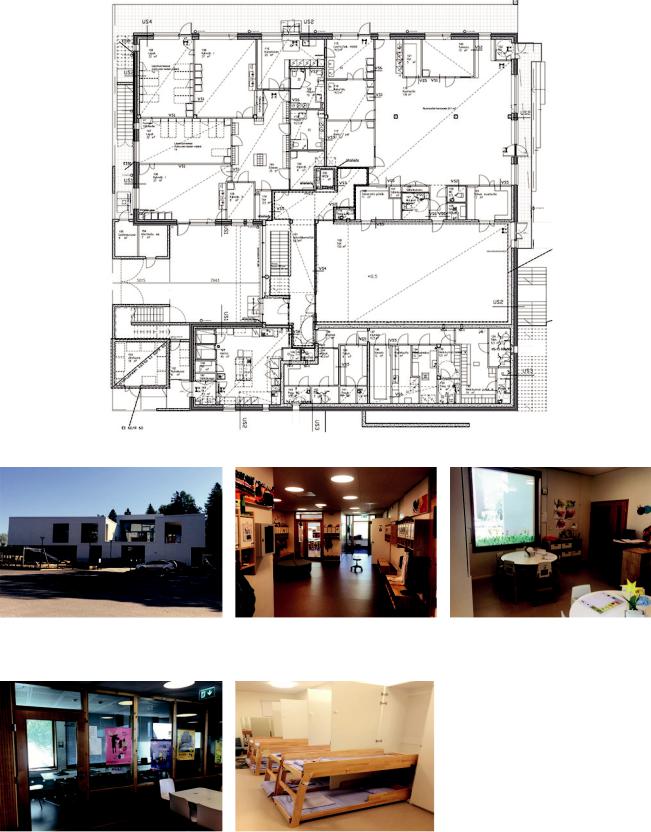
School Design and Learning Environments |
|
in the City of Espoo, Finland |
|
December 2018 |
55 |
Plan and images of the Kirkkojärvi Daycare Centre
The form of the building is a simple compact rectangular block
The common space serving a group of activity spaces
The activity spaces have a range of furniture with tables and chairs for the older children
The building includes meeting spaces |
The sleeping cots fold down |
as part of the administrative areas |
|
